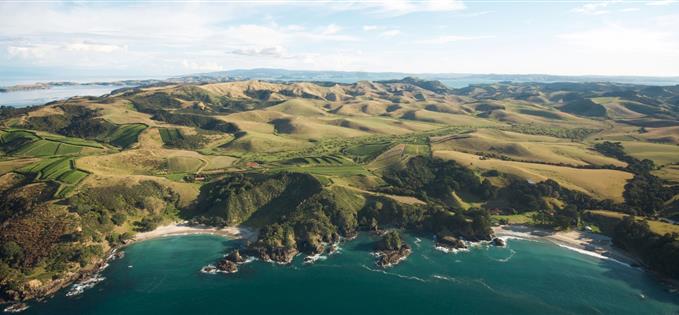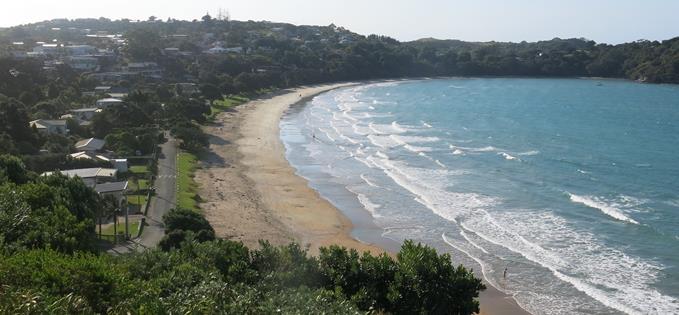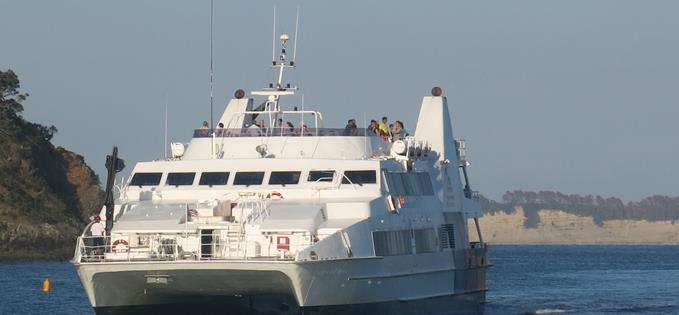MAN O’WAR Bay felt like a voyage of discovery. Not on the epic scale of Captain Cook, who dropped anchor along this rugged coastline in 1769. Sighting the monumental Kauri trees ashore, Cook noted in his journals that they would make ideal masts for the Navy’s Man O' War battleships. Hence the name that survives today, made famous worldwide by the winery there.
You can book a tide-dependent gannet jeep safari along the beach
We had hired a car to reach our tasting. Public transport is non-existent in the remote eastern half of Waiheke Island, named recently as one of the 10 coolest places in the world by Lonely Planet and just a 30 minute ferry ride across the bay from vibrant Auckland, our New Zealand entry point. It took a little longer to get to Man O’War, driving the final 10 miles along narrow dirt roads.
There we tasted an array of wines sourced from 150 acres of vines in 76 different blocks (including an island, which makes harvesting tricky). The rest of the privately owned estate’s 4,500 acres is devoted to stock rearing.
We followed the tasting with a lunch of meat and cheese platters in the garden overlooking the glorious bay where one visitor waded in from her chi-chi yacht.
 Cable Bay sunset; below, scallops from Mudbrick tasting menu
Cable Bay sunset; below, scallops from Mudbrick tasting menu

It’s not uncommon for helicopters to land folk here and at Cable Bay and Mudbrick, wineries with excellent restaurants on the west coast – and equally good sunsets across island-studded Hauraki Gulf to distant Auckland’s Skytower. There are 30 wineries across this 92 sq km island, the most famous of which is Stonyridge, whose Bordeaux-style Larose is sold out in advance each year.
The semi-tropical hippie paradise that Waiheke was once is now infiltrated by the mega-rich, thankfully those who like to dress down and hang loose. That post-long haul chill out featuring glorious beaches such as Onetangi, welcoming wineries with superb food set the pattern for our own further travels down to the southern tip of North island and across to the South Island. Check out our luxury stop-off at The Lodge at Kinloch near New Zealand’s largest lake, which has everything – except wineries.


On the surface our next stop, Napier couldn’t be further from Waiheke. Art Deco dominates phantasmagorically like some Thirties Hollywood film set. The reason? Back in 1931 an earthquake destroyed this most English of Kiwi towns (streets are still named Byron, Tennison etc) and it was rebuilt in the compatible styles of the early 20th century – Arts and Crafts, Mission, Eqyptian – its model California’s Santa Barbara, which had suffered a similar catastrophe six years earlier.
It most striking feature is the dead straight 2km Marine Parade of Norfolk Pines and various Art Deco flourishes alongside a pebbly foreshore. An active Art Deco Trust keeps its architectural legacy (we missed the annual festival by a week), but it doesn’t feel like a museum. Just a sophisticated settlement comfortable in it own skin with a delightful Mediterranean climate.
 Gimblett Gravels; below Richard Painter in the Te Awa vineyards
Gimblett Gravels; below Richard Painter in the Te Awa vineyards

Its other main attraction? It’s the gateway to the Hawke’s Bay wine region, one of New Zealand’s finest, in particular for big reds sourced from the iconic Gimblett Gravels – 700 ha of deep gravel beds, layered with silt and loamy sand, that were rescued from being a landfill site only 30 or so years ago when their vine-growing potential was realised.
On a baking hot summer’s day we lunched on the restaurant patio of one of its best wineries, Te Awa, with winemaker Richard Painter and his dog. Te Awa means ‘River of God’ — referring to the mysterious subterranean streams which help the free draining soil to consistently produce high quality fruit. Richard has even been experimenting successfully with Spanish grape varieties such as Tempranillo and Albarino. Between the vineyard areas lie massive organic fruit orchards. After plates of cured meats accompanied by Pinot Gris and Syrah, it felt like paradise.
 Te Mata; overlooking Craggy Range, below
Te Mata; overlooking Craggy Range, below

Yet this was merely the aperitif for our next stopover just 18 miles away – Craggy Range, where we stayed in one of the vineyard’s own cottages in the shadow of the 400m high Te Mata Peak, boundary of the Hawke’s Bay wine region. After our tasting of the wine range which earned Craggy Range 2014 New World Winery of the Year – but before a long, liquid lunch (we were going nowhere the rest of the day) – we drove up to the top of the peak, which offers terrific scenic walks and a great back story.
Legend has it that the Heretaunga Plains tribes were under constant war threat from the coastal tribes of Waimarama. A wise woman suggested that if Waimarama chief Te Mata, a giant, could be made to fall in love with their princess, Hineraku it might turn his thoughts to peace. And indeed he fell under her spell. Now the vengeful Heretaunga demanded that Hinerakau make Te Mata prove his devotion by accomplishing impossible tasks. The last of these was to bite through the hills between the coast and the plains, to make access easier. He died doing so, leaving today’s The Gap, while his prostrate body forms Te Mata Peak.
 Craggy Range; below Terroir's terrace, deep-fried zucchini flowers and a delectable clam dish
Craggy Range; below Terroir's terrace, deep-fried zucchini flowers and a delectable clam dish



Our host, Michael Bancks, told us the story as we ordered a less daunting feast at Craggy Range’s French-influenced Terroir restaurant, one of the country’s best, where he is sommelier. Out in the garden surrounded by vines, eating a procession of oysters, clams, deep fried zucchini flowers stuffed with goat cheese, rack of lamb with ratatouille, truffle jus, eggplant caviar, seared duck breast with pea tortellini, sour cherry and Madeira jus, it felt eerily like France.
Michael, who previously worked for legendary Michel Guerard after a childhood in Brittany and school days in Auckland, explained the Single Vineyard philosophy of Craggy Range that was created from scratch only in 1997. So Riesling and Pinot Noir come from the appropriate microclimate of Martinborough, while Chardonnay and Syrah come from Gimblett Gravels.

So the beautiful centrepiece of the operation, where we were staying in one of the beautifully equipped Vineyard Cottages (pictured above), is just that, rather than a large-scale working winery.
As evening fell, we ambled around the vines and grounds, taking selfies with the lakeside bronze Charolais cattle sculptures commissioned from internationally-renowned Paul Day. Ahead room service mains from Terroir and the best choice of wine I’ve ever had in a lodging. Heaven.
 Cape Kidnappers – home to a vast gannet colony
Cape Kidnappers – home to a vast gannet colonyDown the road from Craggy Range is the spectacular Cape KIdnappers, another anchorage for Captain Cook’s Endeavour. It gets its name from the kidnap of two Tahitian interpreters by local Maoris, who believed they were slaves. The big draw for today’s visitors is the vast gannet colony. During the breeding season (July-mid October) the cape is closed to the public; the rest of the year it’s an 11km walk to reach the colony or you can book a tide-dependent gannet jeep safari along the beach.
Our final stop before catching the Interislander Ferry across to the South Island was the attractive wine village of Martinborough (not to be confused with Marlborough, New Zealand’s biggest and most high profile region). This is a mecca for weekenders up from capital Wellington.

Star winery is the family-run Ata Rangi. The name means ‘new dawn’ or ‘fresh beginning’, but in New Zealand winemaking terms it has been around a good while, perfecting Pinot Noirs that vie to be the country’s best. Pioneer Clive Paton, planted the first vines on a small, stony sheep paddock at the edge of the village in 1980 and 30 years later it status was confirmed when it was honoured with the inaugural "Grand Cru of New Zealand”. The place is not geared up with a restaurant, just a tasting shed, but there are neighbouring wineries that cater more for the visitor and the village offers excellent bars, cafes and the vintage charm of the restored Martinborough Hotel. Plus if you are shy of visiting vineyards (don’t be), there’s the wine centre on Kitchener Street, stocking a representative range.

Auckland
On our road trip we deliberately avoided the big cities such as Wellington and Christchurch, but we flew in and flew out of Auckland with Cathay Pacific via Hong Kong on the way out, having taken advantage of the four-times a week direct service from Manchester. Hong Kong, with its terrific Cathay Pacific lounge, is a hub connecting with 190 destinations globally (there’s a new route from Gatwick launching in September, too).
Auckland, with its sublime natural surroundings, initially seemed kind of quiet after Hong Kong, especially when we were keen to hit Waiheke, but the more we spent time in its bars and art galleries we grew to enjoy its youthful, multicultural vibe.
Princess Wharf and the Wynyard Quarter are lively, touristy waterfront destinations but for something edgier and more raucous check out after dark inland Karangahape Road, universally known as ‘K Road’. It destroys all those preconceptions Brits have about the Kiwis being locked in some Fifties time warp. Not around here, mate.
 Auckland by night from our Harbour Oaks apartment
Auckland by night from our Harbour Oaks apartmentThe second leg of our New Zealand road trip was on the South Island. Read about it here.
Grape expectations: For wine tasting notes and recommendations from my trip visit this link.
Fact file
Return fares from Manchester to Auckland, via Hong Kong cost from £1,039 in economy, £2,309 in premium economy and £4,109 in business class. Cathay Pacific flies from London Heathrow to Hong Kong five times daily and from Manchester to Hong Kong four times per week, and onwards to over 190 destinations globally. As of September, it will also fly from Gatwick to Hong Kong four times per week. For further information, visit www.cathaypacific.co.uk or call 0208 834 8888.
In Auckland Neil Sowerby stayed at Auckland Harbour Oaks, 16 Gore Street. This aparthotel is very central, a couple of blocks from the waterfront and major attractions. His base on Waiheke was Kiwi House, Oneroa (pictured below) close to one of the island's best beaches.

Craggy Range, 253 Waimarama Road, Havelock North, Hawke’s Bay.
100 Per Cent New Zealand website can help you plan your own classic wine route.
Neil Sowerby parked long stay at Manchester Airport. For full details of parking there visit this link.
 Man O'War; below, its garden, wine tasting at Stonybridge, Oneroa Beach and the Waiheke Ferry
Man O'War; below, its garden, wine tasting at Stonybridge, Oneroa Beach and the Waiheke Ferry













